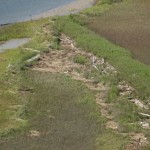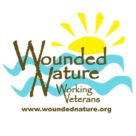 Wounded Nature-Working Veterans’ mission is to remove trash and debris located in hard-to-access coastal areas. We do not study or talk about coastal environmental problems, we take remedial action to fix the problem. We travel to these hard-to-reach coastal areas, usually by boat, wade through marsh grasses, squish our way through marsh mud, and endure oyster and barnacle cuts to remove trash and debris from critical wildlife coastal habitats. Many of those involved in our cleanups, including myself are veterans.
Wounded Nature-Working Veterans’ mission is to remove trash and debris located in hard-to-access coastal areas. We do not study or talk about coastal environmental problems, we take remedial action to fix the problem. We travel to these hard-to-reach coastal areas, usually by boat, wade through marsh grasses, squish our way through marsh mud, and endure oyster and barnacle cuts to remove trash and debris from critical wildlife coastal habitats. Many of those involved in our cleanups, including myself are veterans.
The coastal trash and debris we go after is much greater in volume than what most people have ever seen. The reason the public and boaters have never seen this trash is because it is hidden. It usually resides on the ground at the high tide line hidden behind the shrubs and marsh grasses. Due to the difficulty of getting the trash and debris out of these areas and back to a dock, most of the areas we go to have never been cleaned up before.
Within these cleanup areas, we have observed “wildlife dead zones” that we have associated with collection points for treated lumber. These pieces of lumber were once docks and piers that were broken apart and washed away in past storms. Being dead does not mean being devoid of all life. These areas are usually populated with fiddler crabs but missing the populations of baby shrimp and fish fry. In many treated lumber debris areas the shellfish stocks are either reduced or missing completely.
Upon observing the impact treated lumber appears to have on our environment, I checked to see if I could find any past or current studies defining the problem and I could not find any. What I did discover was that there is a lot of opposition to having a study conducted. The wood industry does not want the impact of their products on the coastal environment studied because if a problem is defined, treated lumber may be banned from use on coastal structures. Commercial fishermen do not want coastlines containing treated lumber to be studied because it could result in areas being closed to fishing. The commercial seafood industry does not want domestic seafood tested for chemicals used in treated lumber due to increased testing costs combined with the possibility of some species that may be susceptible to these chemicals being stigmatized and becoming unsalable seafood species.
To understand the problem you need to understand treated wood. Old treated lumber consisted of wood soaked in arsenic and coated with creosote. Treated lumber in use today consists of three types of preservative treatments; creosote, oil-borne chemicals, and waterborne chemicals. Creosote is made from oil tar chemicals and is best known for the skin burns that are caused when handling wood treated with this chemical. The most popular oil-borne preservative chemical is penta (pentachlorophenol) which causes birth defects and fetal damage, among other health problems in humans. Creosote and Penta are both restricted-use pesticides. For waterborne chemically treated lumber, chromate copper arsenate (CCA), ammoniacal copper zinc arsenate (ACZA), and ammoniacal copper quaternary compound (ACQ) are used. It is estimated that for waterborne chemically treated wood, CCA is used more than 90% of the time. CCA compounds are also highly toxic and regulated as pesticides by the EPA.
There are many warnings for how and where to use treated lumber and I am sure, under normal circumstances and when used properly, it may not pose much of a hazard for humans. However, treated lumber after being broken from its moorings, floating in salt water, and then being deposited along with other trash and debris in rural high-tide coastal areas, is hurting marine wildlife and the environment.
During high tide flushes these areas are like giant washing machine agitators as the water movement causes trash and litter to roll over other items and rub abrasively together. This causes plastic and Styrofoam items to be constantly broken into smaller and smaller pieces. It also works to continuously sandpaper and file down the surfaces of treated lumber residing in these high-tide areas. In between the high tide flushes, this wet-treated wood sits in saltwater mud and reacts with the corrosive chemicals that make up salt water. This causes a slow leaching of the pesticides embedded into the wood. Then the high tide cycle comes in and disperses these leeched chemicals into the tidal marsh surrounding the treated lumber.
We need to fix the problem by removing the treated lumber residing in these high-tide areas. The way the marine conservation non-profit industry normally works is that a researcher will discover a problem that affects our oceans and then the large wildlife and environmental non-profits evaluate whether or not they can leverage the issue to raise money. Once they decide to “embrace” the problem, they immediately start lobbying Congress for grant funding to be included in future budgets and educating high-net-worth individuals. We have seen this happen with shark finning, acidification, whale culls, etc. What they look for in a marine-related problem is being able to obtain public support and acquire multi-year funding for advocacy, research, and public outreach.
We would rather not see this happen with the treated lumber issue. We do not want any new laws passed. We do not want the lumber laying on these rural coastlines studied, common sense and the surrounding dead zones already tell us that treated lumber is bad for wildlife and the environment. We also do not want to see tens of millions of dollars spent on lobbying or educating the public about treated lumber.
We prefer to circumvent this process by just going out and removing the treated lumber from our coastal areas. Treated lumber from old docks and piers can be found in coastal areas on the Great Lakes, Pacific Coast, Gulf Coast, and the East Coast.
Due to weather seasonality combined with the amount of debris needing to be removed, we know that remedial action cannot restore all of these areas in one season. However, we believe this is a problem that can be fixed. Because of our experience removing coastal debris, we know that we can make a significant impact on returning most of our rural coastal areas to their original, pristine condition within 7-10 years.
The total cost to tackle this project on all of our coasts simultaneously is just under 11 million dollars annually. Rather than delaying the removal of this lumber or politicizing the problem, Wounded Nature–Working Veterans is seeking private donations to cover the cost required to fix the problem. We plan to utilize unemployed veterans living aboard boats working year-round.
You can learn more about our plans from our YouTube video sponsored by Chevrolet: Vehicles of Change. Wounded Nature-Working Veterans.
We believe it costs much more money to launch an advocacy and/or public outreach campaign than it would to just clean up our coastlines. We also believe an advocacy campaign could delay cleanups until multi-year research studies, needed to support advocacy campaigns, are completed.
Companies and individuals who want to help in this massive and important cleanup effort can click to Support Wounded Nature-Working Veterans.
